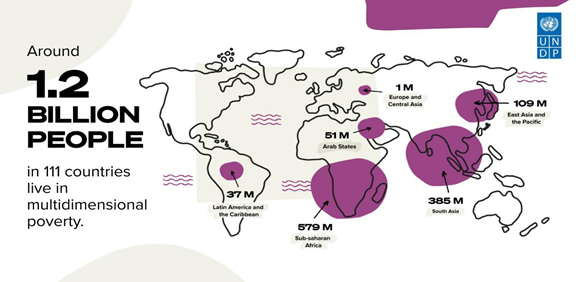

18th October 2022 (8 Topics)
Context
-
The recently released Global Multidimensional Poverty Index (MPI) indicates that 41.5 crore people exited poverty in India during the 15-year period between 2005-06 and 2019-21.
The Global Multidimensional Poverty Index:
- Definition: The global Multidimensional Poverty Index (MPI) is an international measure of acute multidimensional poverty covering over 100 developing countries.
- It complements traditional monetary poverty measures by capturing the acute deprivations in health, education, and living standards that a person faces simultaneously.
- Developed by: The global MPI was developed by Oxford Poverty and Human Development Initiative (OPHI) with the UN Development Programme (UNDP) for inclusion in UNDP’s flagship Human Development Report in 2010.
- It has been published annually by OPHI and in the HDRs ever since.
- The global MPI constructs a deprivation profile of each household and person through 10 indicators spanning health, education, and standard of living and includes both incidences as well as the intensity of poverty.
- All indicators are equally weighted within each dimension.
- The global MPI identifies people as multi-dimensionally poor if their deprivation score is 1/3 or higher.
Key Highlights: (India-specific Data)
- It shows that the incidence of poverty fell from 55.1% in 2005-06 to 16.4% in 2019-21 in the country.
- The deprivations in all 10 MPI indicators saw significant reductions as a result of which the MPI value and incidence of poverty more than halved.
- About 41.5 crore people exited poverty in India during the 15-year period between 2005-06 and 2019-21, out of which two-thirds exited in the first 10 years, and one-third in the next five years.
- Improvement in MPI for India has significantly contributed to the decline in poverty in South Asia.
- It is for the first time that it is not the South Asian region with the highest number of poor people, at 38.5 crores, compared with 57.9 crores in Sub-Saharan Africa.
- The report doesn’t fully assess the effects of the COVID-19 pandemic on poverty in India as 71% of the data from the National Family Health Survey-5 (2019-2021) relied upon for MPI were collected before the pandemic.
- Bihar is the poorest State in 2015-2016, seeing the fastest reduction in MPI value in absolute terms. The incidence of poverty there fell from 77.4% in 2005-2006 to 34.7% in 2019-2021.

India’s present scenario:
- India has by far the largest number of poor people worldwide at 22.8 crores, followed by Nigeria at 9.6 crores.
- Two-thirds of these people live in a household in which at least one person is deprived of nutrition.
- There were also 9.7 crore poor children in India in 2019-2021.
- About 4.2% of the population in the country still lives in severe poverty.
- Rural areas account for nearly 90% of poor people.


